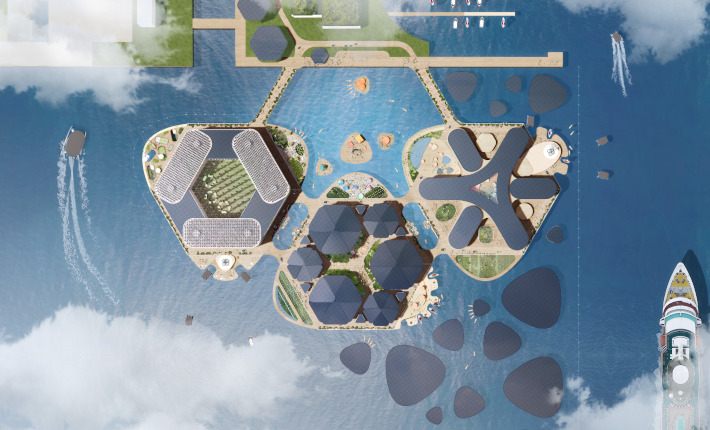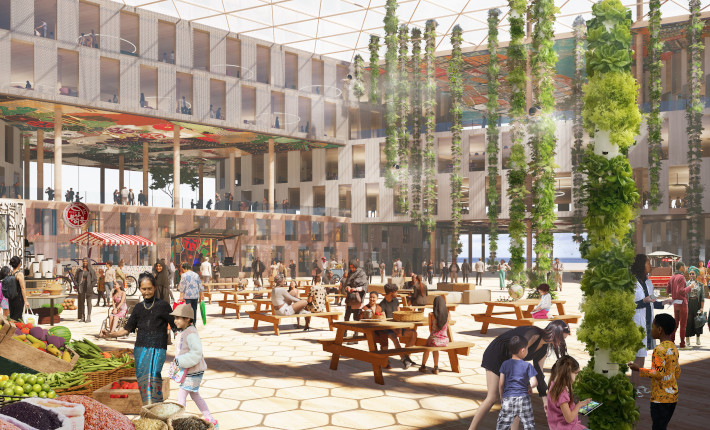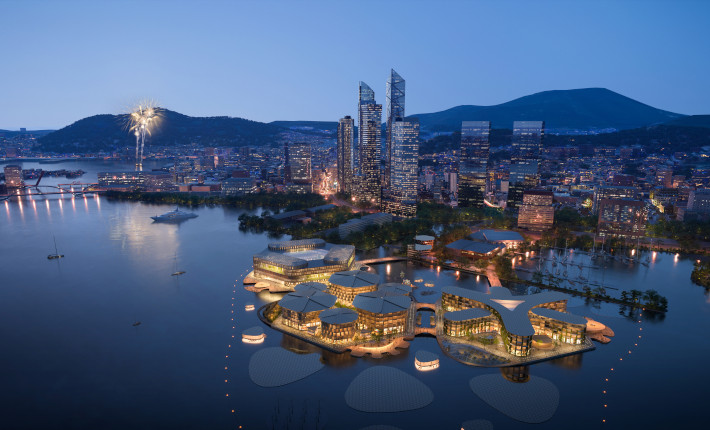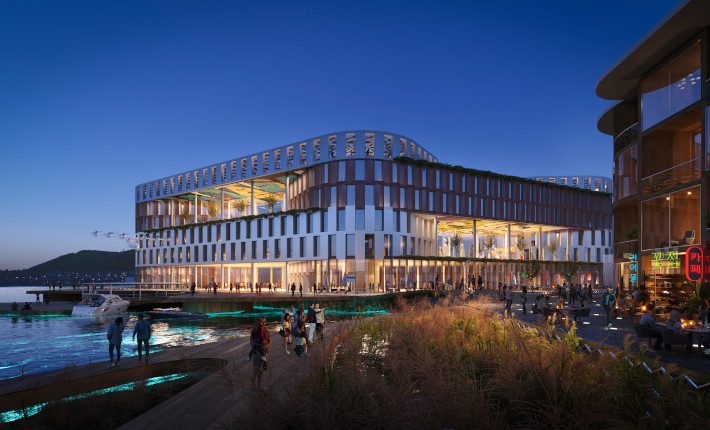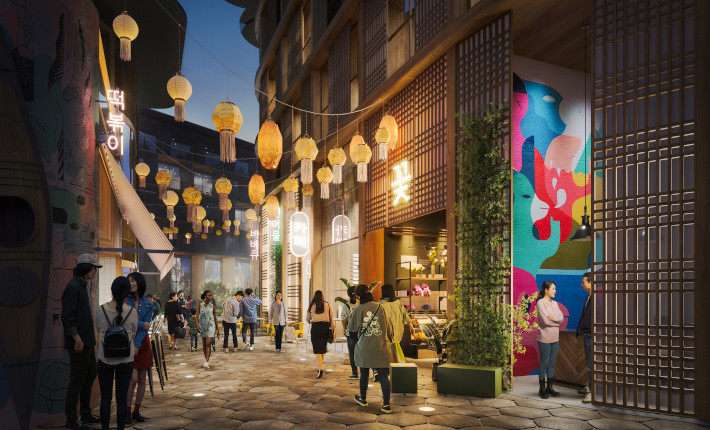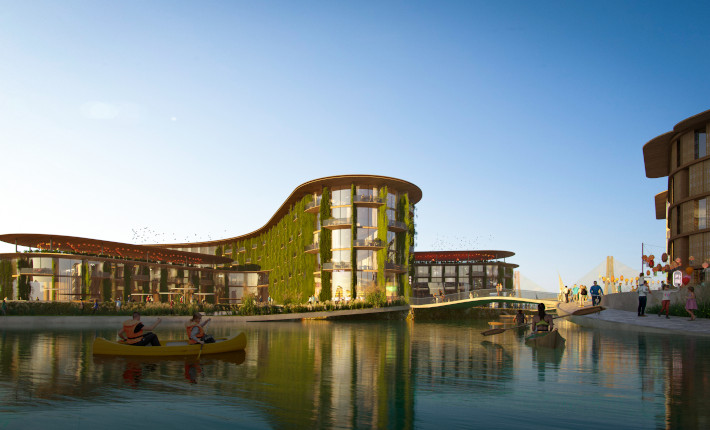OCEANIX Busan | The world’s first prototype floating city at the coast of South Korea
Recently the United Nations unveiled its prototype for the world’s first floating city, the futuristic Oceanix Busan will be located off the coast of the city of Busan in South Korea. OCEANIX Busan is created by the Danish architect Bjarke Ingels in partnership with the UN and maritime development firm Oceanix. The project aims to provide breakthrough technology for coastal cities facing severe land shortages that are compounded by climatic threats.
In this article a video about this floating city. We are curious what type of sustainable restaurant and hotel concepts we will spot in this city!
3 minutes read
OCEANIX Busan | A floating city that adapts to sea level rise
The challenge is massive: two out of every five people in the world live within 100 kilometres of the coast, and 90 percent of mega cities worldwide are vulnerable to rising sea levels. Flooding is destroying billions of dollars’ worth of infrastructure and forcing millions of climate refugees to leave their homes. With nowhere to expand, rapid urban population growth is pushing people closer to the water, driving housing costs to prohibitive levels, and squeezing the poorest families out. More information in the article at UN Habitat, link in the title.
“Today is a pivotal milestone for all coastal cities and island nations on the frontlines of climate change. We are on track to delivering OCEANIX Busan and demonstrating that floating infrastructure can create new land for coastal cities looking for sustainable ways to expand onto the ocean, while adapting to sea level rise,” said the Chief Executive Officer of OCEANIX, Mr. Philipp Hofmann.
OCEANIX, a blue tech company based in New York, led a team of the world’s best designers, engineers, and sustainability experts in designing the flood-proof prototype. The BIG-Bjarke Ingels Group and SAMOO (Samsung) were the lead architects of OCEANIX Busan, unveiled at the Second UN Roundtable on Sustainable Floating Cities; a follow up to the inaugural Roundtable in April 2019, where it was agreed to build a prototype with a host city. Busan signed on last year.
The City of Busan’ credo | The First to the Future
“As Mayor of the Metropolitan City of Busan, I take seriously our commitment to the credo ‘The First to the Future’. We joined forces with UN-Habitat and OCEANIX to be the first to prototype and scale this audacious idea because our common future is at stake in the face of sea level rise and its devastating impact on coastal cities,” said Mayor Park Heong-joon, who has set an ambitious agenda, including turning Busan into a green smart city and launching a bid for World Expo 2030. Speaking at the Roundtable, which took place at the UN Headquarters in New York, and was attended by government ministers of housing, Mayors, Ambassadors, and high-ranking UN officials, the Executive Director of UN-Habitat, Ms. Maimunah Mohd Sharif said. “We cannot solve today’s problems with yesterday’s tools. We need to innovate solutions to global challenges. But in this drive for innovation, let’s be inclusive and equitable and ensure we leave no one and no place behind. I am happy this Roundtable takes place ahead of the High Level Meeting on the New Urban Agenda, where cities and countries around the world come together to discuss sustainable urbanization.”
Waterborne urbanism
“OCEANIX’s modular maritime neighborhood will be a prototype for sustainable and resilient cities. As our first manifestation of this new form of waterborne urbanism, OCEANIX Busan will expand the city’s unique character and culture from dryland into the water around it. We believe OCEANIX’s floating platforms can be developed at scale to serve as the foundations for future resilient communities in the most vulnerable coastal locations on the frontlines of climate change,” says Bjarke Ingels, Founder and Creative Director, BIG-Bjarke Ingels Group.
OCEANIX Busan is a sustainable floating community
OCEANIX Busan is the world’s first prototype of a sustainable floating community. The interconnected platforms total 15.5 acres to accommodate a community of 12,000 people. Each neighborhood is designed to serve a specific purpose – living, research, and lodging. There are between 30,000 to 40,000 square meters of mixed-use programs per platform. The floating platforms connect to land with link-span bridges, framing the sheltered blue lagoon of floating recreation, art, and performance outposts. The low-rise buildings on each platform, defined by their soft lines, feature terraces for indoor-outdoor living activating the network of vibrant public spaces. OCEANIX Busan will organically transform and adapt over time based on the needs of Busan. Starting from a community of 12,000 residents and visitors, it has the potential to expand to accommodate more than 100 000 people. The floating platforms are accompanied by dozens of productive outposts and greenhouses. OCEANIX Busan has six integrated systems: zero waste and circular systems, closed loop water systems, food, net zero energy, innovative mobility, and coastal habitat regeneration. These interconnected systems will generate 100% of the required operational energy on site through floating and rooftop photovoltaic panels. Similarly, each neighborhood will treat and replenish its own water, reduce and recycle resources, and provide innovative urban agriculture.
The video shows the project!
Website: UN-Habitat & OCEANIX city & BIG-Bjarke Ingels Group



